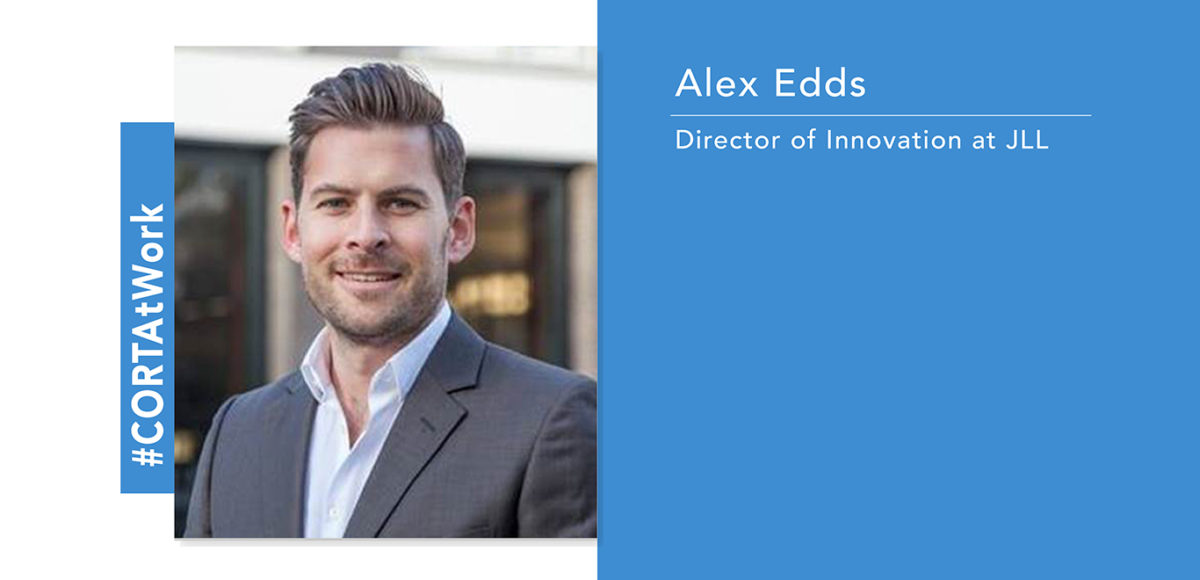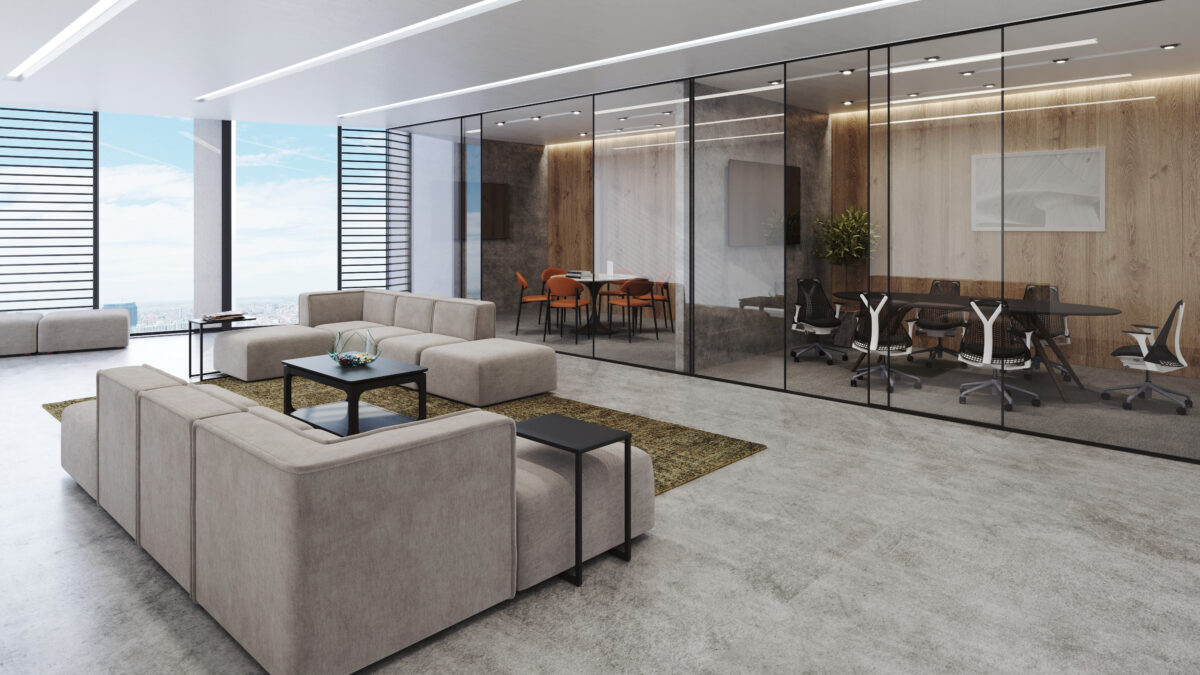This article is part of the “CORT Workplace Talk” series where Melanie Jones, CORT’s National Director, CRE Partnerships, sits down with thought leaders in commercial real estate to discuss advancements, insights, and trends within the industry. Sit back and learn more about CRE and how CORT Furniture Rental can benefit your organization.
I first met Alex Edds, Director of Innovation at JLL, through the global network of graduates from Dror Poleg and Antony Slumber’s Real Innovation Academy.
Personally, I’m investing time and energy to learn more about the broad topic of sustainability, reducing our carbon footprint, GHG, renewables, food production, water supplies, and so on. Professionally, I’m listening to thought-leaders like Alex to understand how the sustainable CORT Furniture-as-a-Service™ offering can better support the built environment and the growing interest in a circular economy in commercial real estate.
Those who know Alex certainly agree he is a thoughtful, passionate, and driven leader who has taken risks throughout his life. And developing a friendship with him has been a privilege for me. If just a few people are inspired to take action and learn more about sustainability in commercial real estate, then the effort to capture these thoughts will have been worth it. Enjoy.
Melanie Jones: I am jumping right in here. You shared with me that some people have exhausted the topic of sustainability. Still, others are just awakening to the urgency in understanding where we are, what needs to happen, and why.
In my case, two of my three children work in leadership positions in the renewable energy field, and they’ve encouraged me to learn and share more. Would you begin by providing a very high-level viewpoint on ESG (Environmental, Social, and Governance) and what you are seeing?
Alex Edds: For some time, there’s been a significant focus on the environmental side of sustainability, which I think is still the dominant discussion. People tend to go straight to energy and carbon and call that sustainability.
You’ve got the environmental side of sustainability, and the impact that we have, such as energy and carbon emissions, and this is clearly important to help alleviate the climate crisis and other environmental hazards.
But sustainability is more than just the environment. We have to bridge the gap between environmental, social, and governance and focus on the whole.
MJ: Do you have a few examples?
AE: I have many. Let’s take air quality since that’s surfaced recently in a big way. Health and wellness are quickly becoming a hot topic and prevalent in conversations with commercial real estate. As a whole, there is a huge focus on monitoring air quality. Both in terms of the polluting element – which is the E-environmental – as it is typically driven by fossil fuel use and, or, dust from human activity and can cause issues for the natural biosphere. But it also has a big impact on us, humans. And as the science and awareness of that grows, people and companies are starting to ask, “How do we improve the air quality within a space?” whether this is at home, work, or school. This is the S – social. This is an excellent example of supporting the social impact on people by understanding the environmental challenges.
Think about what happens when wearable technology or a mobile phone can assess and deliver the feedback data on air quality in real-time? Imagine when an employee steps into a building with unsafe air quality? When ESG data gets into the hands of the masses, and it will, how will we navigate change? What does the liability conversation look like? This is going to be absolutely critical.
Beyond the immediate impact on our health, there is a broader definition of S. The social value that the urban environment creates. Think of a developer who tears down an old office building and rebuilds it with, say, a bowling alley, hospital, or school. What’s the social value of this to the community? Although this type of activity is more difficult to measure and is rarely calculated, I expect we will see change like this supporting the ESG conversation.
MJ: You are right, Alex. In our space, we are trying hard to connect and change mindsets on furniture utilization and the value of a circular solution.
We collaborate with JLL and your clients often with traditional swing spaces, short-term office leases, sublease solutions, amenity areas, and so forth. For example, here is our work with the JLL team in Atlanta. I must say, I do look forward to the day when we are part of the sustainability conversation and client solution! I think, generally speaking, people are becoming much more receptive to such discussions, don’t you?
AE: I do. I remember the days where people thought I was a “tree hugger” and a bit weird. No longer, thankfully, as most people in business have a keen interest now, or at least understand why it is important.
And the next phase will likely be for companies to figure out how to differentiate their offerings and find ways to monetize sustainability. That will continue to build awareness and encourage innovative thinking.
MJ: Alex, your background is interesting. At JLL, you worked as UK Head of Sustainability before moving into the Director of Innovation role. JLL was a pioneer in creating an internal sustainability role in the UK and then providing you the opportunity to craft your current position and mission. What are the highlight moments from your journey?
AE: Sustainability is an outcome. It’s an outcome we’re all seeking and trying to deliver. At JLL we strive to deliver better buildings, better cities, better quality, and better experiences. So I’ve been fortunate to stay pretty much aligned to my moral compass, my vision, you could say, of delivering outcomes.
I knew early on what I wanted to spend my time doing, was able to get an education that helped me enter into a field that was relatively new. When I was offered my first job in my field, and they were going to pay me to focus on what I loved, it was simply amazing to me!
My time at Upstream, especially, was extremely valuable. Upstream was purchased by JLL in 2007 and is still operational today. Upstream was one of the very first commercial real estate environmental consultancies teams in the world.
One of the highlights of my career has been the ability to take some risks because of a driving passion for delivering positive change in my field. I spent almost ten years at Upstream – learning a great deal and building my knowledge in the fundamentals of sustainable real estate – such as legislation, regulation, benchmarking and gathering data, transparency, reporting. This is a vital part of the equation and knowing the detail, and importantly – how to achieve it – is critical.
I then decided I needed a change. I wanted to focus on new ideas, new ways of focusing on the problems, and trying to address the outcomes more quickly. Most of us want the satisfaction of going to work and being able to see the progress and tangible results from the things we impact and be proud of our work, and I felt I needed some of that!
MJ: Risk-takers need an occasional “shot in the arm” of satisfaction and reflection on progress. It fuels us onward.
A big part of determining incremental success is understanding what data and outcomes need to be measured and analyzed. There is the human element to all this, too, and the reality that big topics have a polarizing effect. I love your perspective on desiring satisfaction from your mission. And, I know firsthand that the next few generations will make many important decisions thinking along similar lines!
Because this topic is of interest to me, I’ve been reading things like the 2021 Annual Corporate Sustainability Assessment by SP Global. It’s full of interesting information. For example, they include the United Nations statistic that buildings are responsible for 40% of global energy consumption and 33% of GHG emissions throughout their lifetime.
AE: Certainly, many KPIs are being measured, more so every year. In addition to energy consumption and GHG emissions consider about ¼ of all water consumption is tied back to buildings. Although tricky to compile numbers from complex supply chains, we must also analyze and factor in emissions and environmental problems from activities such as construction manufacturing, cement manufacturing, mining and extraction, waste, transportation, and so on.
In my experience, the more data we have, the better we can understand the problems and then look to solve the problems.
MJ: I understand that in your current ‘innovation’ role, you are client-facing. I imagine you speak with CRE sustainability leaders, developers, and occupiers, right?
AE: Yes, my role now is more about developing the operating models and delivering the digital transformation needed to achieve desired outcomes. From an ESG perspective, this often means delivering ‘smart buildings.’ However, a smart building is nothing without the outcomes. Why is it smart? What is it is trying to do?
Perhaps a better customer experience? Or leveraging of technology to facilitate health and wellness, evaluate occupancy, or monitor air quality?
To help achieve these outcomes, it is essential first to understand what’s driving the desired change. Is a particular developer or landlord trying to deliver a more sustainable building by driving down construction or other costs?
Do they need to reduce the carbon footprint because this data will need to be shared with the investors and the general public?
Or is it to serve up answers to a tenant who is asking, “What are you doing? I want to be in a more sustainable building.”
One common need driving demand is the desire to be Net Zero Carbon. There is a lot of pressure on developers and landlords to deliver net-zero buildings, and we’ve seen an acceleration in demand for help to achieve this.
This presents a huge opportunity right across the value chain. A good example is a valuation. How much is an NZC building worth? If there is a price premium, then this will drive further adoption and investment.
MJ: What about JLL groups like Property Management, Corporate Solutions, and Project & Development Services? Are they involved in client conversations in this area?
AE: We are receiving a tremendous spike in interest and demand on all sides. Our Property Management group, for example, had to bring in sustainability capabilities to support overwhelming interest from clients. Many at JLL are involved in the entry-level conversations are around sustainability, and we are able to quickly escalate the opportunity or project if deep expertise is needed.
MJ: Your role is to enable sustainability outcomes (among others) through innovation. Are changes in sustainability and climate action a fad, or is it the new normal? Do most clients you work with truly care, or are they charged with aligning to new policies and checking boxes?
AE: Certainly not a fad, and we see interest growing for other services over many years. COVID has accelerated interest in some of those (particularly wellness). Still, thankfully the climate agenda has continued to be important and, with some global frameworks and leadership, achieving Net Zero (and other goals) are key corporate drivers. For many of our clients, these are key strategic principles that underpin their business strategy. If we can’t demonstrate that we can help them with sustainability, then we’re not going to win that client.
MJ: As you said earlier, this conversation must expand and broaden.
MJ: On Earth Day 2021, JLL announced a bold commitment to achieving net-zero by 2040. Would you explain what this means and why it’s such a massive step for the overall industry? What needs to happen?
AE: It breaks down in a few ways. JLL is in the service business. We don’t build anything. So, by far, the biggest impact is in advising our clients on how they can achieve net-zero.
However, as a business employing 80,000 globally, we look at our own direct impact. We have hundreds of offices around the world and have fleets of vehicles. Therefore our NZC goal is to drive down the environmental impact of our own footprint through energy savings, renewable energy procurement, and, crucially, as an occupier of space, demanding low embodied carbon buildings to occupy.
The second part, and by far the biggest impact we can have, is how do we best enable our customers, and the industry, to achieve NZC? How do we invest in the right skills? What services do we need to offer? How do we invest in the right technologies? We need all of the parts to come together to take our clients to net zero. We are investing heavily in all of this to meet our goals!
Stay tuned for part two of this conversation next week.
About Alex
Alex advises both JLL leadership and its clients on the technological and systemic disruption facing the property industry. He supports the development of new business, portfolio and asset strategies that seek to embrace and capitalize on market opportunities as a consequence of digital transformation, specifically aimed at helping clients future proof portfolios and buildings for future market needs, and with a personal goal to embed sustainability into real estate decision making.
Prior to this role, Alex has served as Head of Sustainability at JLL, Head of Responsible Property Investment at Nuveen, and Director of Upstream Sustainability Services, JLL.
Alex takes pride in challenging the status quo and believes there is a huge opportunity to improve the built environment by fundamentally changing the way we design, build and manage physical spaces to better serve the people that use them and the environment upon which they depend.
About Melanie
Melanie Jones is responsible for educating, supporting, and building relationships with commercial real estate teams across the US in support of CORT’s Furniture-as-a-Service™ model. A mission-driven leader who brings the necessary energy and innovation to support change in the way furniture is utilized in buildings and the workplace.






